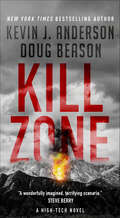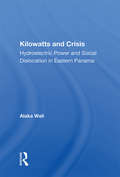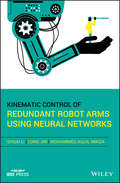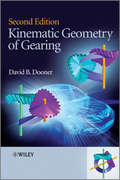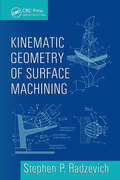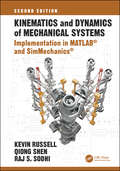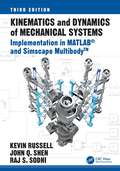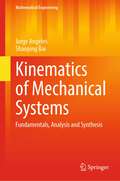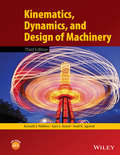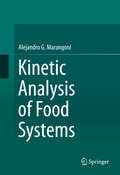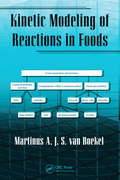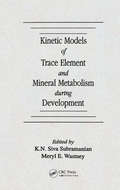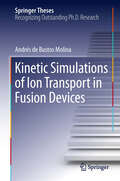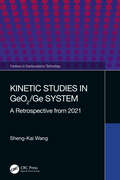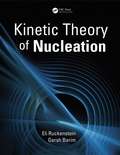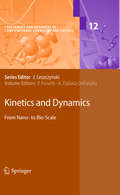- Table View
- List View
Kiebitzinseln in der Agrarlandschaft: Von der Störstelle zum Habitat (essentials)
by Jan-Uwe SchmidtIn diesem essential beschreibt Jan-Uwe Schmidt, wie durch Kiebitzinseln nicht nur dem Kiebitz geholfen wird, sondern auch andere Tier- und Pflanzenarten profitieren k#65533;nnen. Durch j#65533;hrliche Anlage einer Schwarzbrache mit mindestens 2 Hektar Gr#65533;#65533;e lassen sich Nassstellen leicht als Kiebitzbrutplatz einrichten. Landwirte erh#65533;hen so die Nachhaltigkeit der Landnutzung und schaffen au#65533;erdem einen sicheren Erl#65533;s aus der Verg#65533;tung der Agrarumweltma#65533;nahme. Dieses essential gibt praktische Hinweise zur Planung und Anlage von Kiebitzinseln mithilfe von Luftbildern.
Kill All Happies
by Rachel CohnLast Call at Happies! Tonight, 8 P.M. Senior Class Only! Please with the Shhhh?.This is it. Graduation. And Vic Navarro is throwing the most epic party Rancho Soldado has ever seen. She's going to pull off the most memorable good-bye ever for her best friends, give Happies-the kitschy restaurant that is her desert town's claim to fame-a proper send-off into bankruptcy, and oh yes, hook up with her delicious crush, Jake Zavala-Kim. She only needs to keep the whole thing a secret so that her archnemesis, Miss Ann Thrope, Rancho Soldado's nightmare Town Councilwoman and high school Economics teacher, doesn't get Vic tossed in jail. With the music thumping, alcohol flowing, bodies mashing, and Thrope nowhere to be seen, Vic's party is a raging success. That is, until Happies fans start arriving in droves to say good-bye, and storm the deserted theme park behind the restaurant. Suddenly what was a small graduation bash is more like Coachella on steroids with a side of RASmatazz pie. The night is so not going as planned. And maybe that's the best plan of all.
Kill Zone: A High-Tech Novel
by Kevin J. Anderson Doug BeasonPower duo Kevin J. Anderson and Doug Beason team up in Kill Zone, a perilous disaster thriller for the modern age. Deep within a mountain in Albuquerque, New Mexico, a Cold War-era nuclear weapons storage facility is being used to covertly receive more than 100,000 tons of nuclear waste stored across the US. Only Department of Energy employee, Adonia, and a few others including a war hero, a senator, and an environmental activist, are allowed access to perform a high-level security review of the facilities. But Hydra Mountain was never meant to securely hold this much hazardous waste, and it has the potential to explode, taking with it all of Albuquerque and spreading radioactivity across the nation. This disaster situation proves all too possible when a small plane crashes at a nearby military base, setting off Hydra’s lockdown and trapping Adonia and her team in the heart of the hazardous, waste-filled mountain. Now, the only direction for them to go is deeper into the mountain, through the tear gas and into a secretive area no one was ever supposed to know about.At the Publisher's request, this title is being sold without Digital Rights Management Software (DRM) applied.
Kill the Cowboy: A Battle of Mythology in the New West
by Sharman Apt RussellOn ranching, environmentalism, and change -- life and thought in the West, seen through the eyes of some of the players.
Killer on the Road: Violence and the American Interstate (Discovering America #2)
by Ginger StrandTrue crime meets cultural history in this story of how America&’s interstate highway system opened a world of mobility and opportunity . . .for serial killers.Starting in the 1950s, Americans eagerly built the planet&’s largest public work: the 42,795-mile National System of Interstate and Defense Highways. Before the concrete was dry on the new roads, however, a specter began haunting them: the highway killer. He went by many names: the &“Hitcher,&” the &“Freeway Killer,&” the &“Killer on the Road,&” the &“I-5 Strangler,&” and the &“Beltway Sniper.&” Some of these criminals were imagined, but many were real. The nation&’s murder rate shot up as its expressways were built. America became more violent and more mobile at the same time.Killer on the Road tells the entwined stories of America&’s highways and its highway killers. There&’s the hot-rodding juvenile delinquent who led the National Guard on a multistate manhunt; the wannabe highway patrolman who murdered hitchhiking coeds; the record promoter who preyed on &“ghetto kids&” in a city reshaped by freeways; the nondescript married man who stalked the interstates seeking women with car trouble; and the trucker who delivered death with his cargo. Thudding away behind these grisly crime sprees is the story of the interstates—how they were sold, how they were built, how they reshaped the nation—and how we came to equate them with violence.Through the stories of highway killers, we see how the &“killer on the road,&” like the train robber, the gangster, and the mobster, entered the cast of American outlaws, and how the freeway—conceived as a road to utopia—came to be feared as a highway to hell.&“Strand . . . Explores the connection between America&’s sprawling highway system and the pathology of the murderers who have made them a killing ground. . . . The grim stories of murder on the highway may do for road trips what Jaws did for surfing. An interesting detour into a true-crime niche.&” ―Kirkus Reviews&“Strand&’s cross-threaded tales of drifters, stranded motorists, and madmen got its hooks into me. Reading Ms. Strand&’s thoughtful book is like driving a Nash Rambler after midnight on a highway to hell.&” —Dwight Garner, The New York Times&“A titillating, clever volume that mixes the sweeping sociological assertions of an urban-studies textbook with the chilling gore of true-crime stories.&” —Bookforum&“Ginger Strand is in possession of a sharp eye, a biting wit, a beguiling sense of fun—and a magnificent obsession.&” —Bloomberg
Killer on the Road: Violence and the American Interstate (Discovering America #2)
by Ginger StrandStarting in the 1950s, Americans eagerly built the planet's largest public work: the 42,795-mile National System of Interstate and Defense Highways. Before the concrete was dry on the new roads, however, a specter began haunting them-the highway killer. He went by many names: the "Hitcher," the "Freeway Killer," the "Killer on the Road," the "I-5 Strangler," and the "Beltway Sniper. " Some of these criminals were imagined, but many were real. The nation's murder rate shot up as its expressways were built. America became more violent and more mobile at the same time. Killer on the Road tells the entwined stories of America's highways and its highway killers. There's the hot-rodding juvenile delinquent who led the National Guard on a multistate manhunt; the wannabe highway patrolman who murdered hitchhiking coeds; the record promoter who preyed on "ghetto kids" in a city reshaped by freeways; the nondescript married man who stalked the interstates seeking women with car trouble; and the trucker who delivered death with his cargo. Thudding away behind these grisly crime sprees is the story of the interstates-how they were sold, how they were built, how they reshaped the nation, and how we came to equate them with violence. Through the stories of highway killers, we see how the "killer on the road," like the train robber, the gangster, and the mobster, entered the cast of American outlaws, and how the freeway-conceived as a road to utopia-came to be feared as a highway to hell.
Killing It: An Education
by Camas DavisCamas Davis was at an unhappy crossroads. A longtime magazine editor, she had left New York City to pursue a simpler life in her home state of Oregon, with the man she wanted to marry, and taken an appealing job at a Portland magazine. But neither job nor man delivered on her dreams, and in the span of a year, Camas was unemployed, on her own, with nothing to fall back on. Disillusioned by the decade she had spent as a lifestyle journalist, advising other people how to live their best lives, she had little idea how best to live her own life. She did know one thing: She no longer wanted to write about the genuine article, she wanted to be it. So when a friend told her about Kate Hill, an American woman living in Gascony, France who ran a cooking school and took in strays in exchange for painting fences and making beds, it sounded like just what she needed. She discovered a forgotten credit card that had just enough credit on it to buy a plane ticket and took it as kismet. Upon her arrival, Kate introduced her to the Chapolard brothers, a family of Gascon pig farmers and butchers, who were willing to take Camas under their wing, inviting her to work alongside them in their slaughterhouse and cutting room. In the process, the Chapolards inducted her into their way of life, which prizes pleasure, compassion, community, and authenticity above all else, forcing Camas to question everything she'd believed about life, death, and dinner. So begins Camas Davis's funny, heartfelt, searching memoir of her unexpected journey from knowing magazine editor to humble butcher. It's a story that takes her from an eye-opening stint in rural France where deep artisanal craft and whole-animal gastronomy thrive despite the rise of mass-scale agribusiness, back to a Portland in the throes of a food revolution, where Camas attempts--sometimes successfully, sometimes not--to translate much of this old-world craft and way of life into a new world setting. Along the way, Camas learns what it really means to pursue the real thing and dedicate your life to it.
Killing bin Laden: A Moral Analysis
by Bradley Jay StrawserKilling bin Laden: An Ethical Analysis is a short treatise on the possible ethical justification for the U. S. mission to kill Osama bin Laden. After rejecting the standard justifications most commonly used in support of the killing, Strawser ultimately argues that the killing was ethically permissible as an act of defensive harm on behalf of innocents. The book contends bin Laden was morally responsible for a collection of unjust threats such that he was liable to be killed. Moreover, the many unique features of the bin Laden case -such as the use of pre-emptive harm and the collective agency of al-Qaeda - do not defeat that liability. The monograph also includes discussions of the apparent violation of Pakistan's sovereignty and the morally dubious celebrations of bin Laden's death, among other morally relevant issues.
Kilowatts And Crisis: Hydroelectric Power And Social Dislocation In Eastern Panama
by Alaka WaliThis book tells the story of the people of the Bayano region: the pain of resettlement and the courage with which they responded to the threat to their land 1976. The Bayano River, one of three major rivers of the Darien, rushes through the deforested basin which was to be the dam's reservoir. This was an achievement of General Omar TOirijos, th
Kinematic Analysis and Synthesis of Mechanisms
by Asok Kumar MallikThis text/reference represents the first balanced treatment of graphical and analytical methods for kinematic analysis and synthesis of linkages (planar and spatial) and higher-pair mechanisms (cams and gears) in a single-volume format. A significant amount of excellent German literature in the field that previously was not available in English provides extra insight into the subject. Plenty of solved problems and exercise problems are included to sharpen your skills and demonstrate how theory is put into practice.
Kinematic Control of Redundant Robot Arms Using Neural Networks: A Theoretical Study (Wiley - IEEE)
by Shuai Li Long Jin Mohammed Aquil MirzaPresents pioneering and comprehensive work on engaging movement in robotic arms, with a specific focus on neural networks This book presents and investigates different methods and schemes for the control of robotic arms whilst exploring the field from all angles. On a more specific level, it deals with the dynamic-neural-network based kinematic control of redundant robot arms by using theoretical tools and simulations. Kinematic Control of Redundant Robot Arms Using Neural Networks is divided into three parts: Neural Networks for Serial Robot Arm Control; Neural Networks for Parallel Robot Control; and Neural Networks for Cooperative Control. The book starts by covering zeroing neural networks for control, and follows up with chapters on adaptive dynamic programming neural networks for control; projection neural networks for robot arm control; and neural learning and control co-design for robot arm control. Next, it looks at robust neural controller design for robot arm control and teaches readers how to use neural networks to avoid robot singularity. It then instructs on neural network based Stewart platform control and neural network based learning and control co-design for Stewart platform control. The book finishes with a section on zeroing neural networks for robot arm motion generation. Provides comprehensive understanding on robot arm control aided with neural networks Presents neural network-based control techniques for single robot arms, parallel robot arms (Stewart platforms), and cooperative robot arms Provides a comparison of, and the advantages of, using neural networks for control purposes rather than traditional control based methods Includes simulation and modelling tasks (e.g., MATLAB) for onward application for research and engineering development By focusing on robot arm control aided by neural networks whilst examining central topics surrounding the field, Kinematic Control of Redundant Robot Arms Using Neural Networks is an excellent book for graduate students and academic and industrial researchers studying neural dynamics, neural networks, analog and digital circuits, mechatronics, and mechanical engineering.
Kinematic Differential Geometry and Saddle Synthesis of Linkages
by Wei Wang Delun WangWith a pioneering methodology, the book covers the fundamental aspects of kinematic analysis and synthesis of linkage, and provides a theoretical foundation for engineers and researchers in mechanisms design. * The first book to propose a complete curvature theory for planar, spherical and spatial motion* Treatment of the synthesis of linkages with a novel approach* Well-structured format with chapters introducing clearly distinguishable concepts following in a logical sequence dealing with planar, spherical and spatial motion * Presents a pioneering methodology by a recognized expert in the field and brought up to date with the latest research and findings* Fundamental theory and application examples are supplied fully illustrated throughout
Kinematic Geometry of Gearing
by David B. DoonerBuilding on the first edition published in 1995 this new edition of Kinematic Geometry of Gearing has been extensively revised and updated with new and original material. This includes the methodology for general tooth forms, radius of torsure', cylinder of osculation, and cylindroid of torsure; the author has also completely reworked the '3 laws of gearing', the first law re-written to better parallel the existing 'Law of Gearing" as pioneered by Leonard Euler, expanded from Euler's original law to encompass non-circular gears and hypoid gears, the 2nd law of gearing describing a unique relation between gear sizes, and the 3rd law completely reworked from its original form to uniquely describe a limiting condition on curvature between gear teeth, with new relations for gear efficiency are presented based on the kinematics of general toothed wheels in mesh. There is also a completely new chapter on gear vibration load factor and impact.Progressing from the fundamentals of geometry to construction of gear geometry and application, Kinematic Geometry of Gearing presents a generalized approach for the integrated design and manufacture of gear pairs, cams and all other types of toothed/motion/force transmission mechanisms using computer implementation based on algebraic geometry.
Kinematic Geometry of Surface Machining
by Stephen P. RadzevichThe principle of Occam's razor loosely translates tothe simplest solution is often the best. The author of Kinematic Geometry of Surface Machining utilizes this reductionist philosophy to provide a solution to the highly inefficient process of machining sculptured parts on multi-axis NC machines. He has developed a method to quickly calcu
Kinematics and Dynamics of Mechanical Systems, Second Edition: Implementation in MATLAB® and SimMechanics®
by Kevin Russell Qiong Shen Rajpal S. SodhiKinematics and Dynamics of Mechanical Systems: Implementation in MATLAB® and SimMechanics®, Second Edition combines the fundamentals of mechanism kinematics, synthesis, statics and dynamics with real-world applications, and offers step-by-step instruction on the kinematic, static, and dynamic analyses and synthesis of equation systems. Written for students with no knowledge of MATLAB and SimMechanics, the text provides understanding of static and dynamic mechanism analysis, and moves beyond conventional kinematic concepts—factoring in adaptive programming, 2D and 3D visualization, and simulation, and equips readers with the ability to analyze and design mechanical systems.
Kinematics and Dynamics of Mechanical Systems: Implementation in MATLAB® and Simscape Multibody™
by Kevin Russell John Q. Shen Raj SodhiUpdated throughout for the third edition, Kinematics and Dynamics of Mechanical Systems: Implementation in MATLAB® and Simscape Multibody™ offers step-by-step instructions on the fundamentals of mechanism kinematics, synthesis, statics and dynamics, alongside demonstrating its real-world applications. Following updates made by MATLAB, replacing Simmechanics with new system Simscape Multibody, this textbook provides updated instructions and example problems to fully enable the reader to use this new and improved system. New features discussed in the book include enhanced rendering, 3D geometry in animations of user-generated solutions for planar linkages, spatial linkages, and robotic systems. The textbook provides the perfect companion to aid students in analyzing and designing mechanical systems. The book will be of interest to students and professional in the field of automotive engineering, mechatronics and robotics, with a special focus on kinematics, dynamics and machine design.
Kinematics of Mechanical Systems: Fundamentals, Analysis and Synthesis (Mathematical Engineering)
by Jorge Angeles Shaoping BaiThis book is aimed to provide comprehensive and systematic knowledge of kinematic synthesis as developed up to date. Modern mechanical systems require advance kinematics knowledge to support mechanism design with sound theories and methods. The book includes not only the classical foundations of kinematic synthesis, but also the latest advances developed by the authors. Moreover, many examples are included to illustrate both methods and their supporting theory.The focus is on systems of rigid bodies forming closed loops. The four-bar linkage, representing the foundations of mechanical systems, is given due attention, in its three domains: planar, spherical, and spatial. The book contains six chapters, the first two covering fundamentals for kinematic synthesis, including qualitative synthesis. Chapters 3–5 describe, in full detail, the function, motion, and path syntheses of single-dof linkages. In the last chapter, the synthesis of single-dof complex linkages, including six-bar and ten-bar linkages, is introduced.The book is suitable for graduate students of mechanical engineering, researchers of mechanism and robot design, and machine design engineers.
Kinematics, Dynamics, and Design of Machinery
by Gary L. Kinzel Sunil K. Agrawal Kenneth J. WaldronKinematics, Dynamics, and Design of Machinery, Third Edition, presents a fresh approach to kinematic design and analysis and is an ideal textbook for senior undergraduates and graduates in mechanical, automotive and production engineering Presents the traditional approach to the design and analysis of kinematic problems and shows how GCP can be used to solve the same problems more simply Provides a new and simpler approach to cam design Includes an increased number of exercise problems Accompanied by a website hosting a solutions manual, teaching slides and MATLAB® programs
Kinetic Analysis of Food Systems
by Alejandro G. MarangoniThis text provides a comprehensive and thorough overview of kinetic modelling in food systems, which will allow researchers to further their knowledge on the chemistry and practical use of modelling techniques. The main emphasis is on performing kinetic analyses and creating models, employing a hands-on approach focused on putting the content discussed to direct use. The book lays out the requisite basic information and data surrounding kinetic modelling, presents examples of applications to different problems and provides exercises that can be solved utilizing the data provided. Kinetic Analysis of Food Systems pursues a practical approach to kinetic analysis, providing helpful exercises involving chlorophyll degradation in processed vegetables, metabolic oscillations and sugar accumulation in cold-stored potatoes, transesterification of oils to manufacture biodiesel, aggregation of whey proteins to make protein gels and crystallization of fat stabilizers used in nut butters, among others. The book lays out the basics of kinetic modelling and develops several new models for the study of these complex systems. Taken together with the accompanying exercises, they offer a full portrait of kinetic analysis, from its basic scientific groundwork to its application.
Kinetic Modeling of Reactions In Foods (Food Science and Technology)
by Martinus A.J.S. van BoekelThe level of quality that food maintains as it travels down the production-to-consumption path is largely determined by the chemical, biochemical, physical, and microbiological changes that take place during its processing and storage. Authored by an internationally respected food quality expert, Kinetic Modeling of Reactions in Foods demonstrates
Kinetic Models of Trace Element and Mineral Metabolism During Development
by K. N. Siva Subramanian Meryl E. Wastney-PentchevKinetic models are becoming standard tools in the research of biological systems. They are used to represent hypotheses, analyze data, and design experiments to maximize the information obtained from a study. Kinetic Models of Trace Element and Mineral Metabolism During Development describes models for calcium, chromium, copper, iron, iodide, lead, mercury, selenium, zinc, and others in health and disease.
Kinetic Simulations of Ion Transport in Fusion Devices
by Andrés de Bustos MolinaThis thesis deals with the problem of ion confinement in thermonuclear fusion devices. It is a topic of general interest, as it helps to understand via numerical simulations the ion confinement properties in complex geometries, in order to predict their behavior and maximize the performance of future fusion reactors. The main work carried out in this thesis is the improvement and exploitation of an existing simulation code called ISDEP. This code solves the so-called ion collisional transport in arbitrary plasma geometry, improving in this sense other existing codes. Additionally, it presents outstanding portability and scalability in distributed computing architectures, such as Grid or Volunteer Computing. The main physical results can be divided into two blocks. First, the study of 3D ion transport in ITER is presented. ITER is the largest fusion reactor (under construction) and most of the simulations so far assume the axis-symmetry of the device. Unfortunately, this symmetry is only an approximation because of the discrete number of magnetic coils used. ISDEP has shown, using a simple model of the 3D magnetic field, how the ion confinement is affected by this symmetry breaking. Secondly, ISDEP has been applied successfully to the study of fast ion dynamics in fusion plasmas. The fast ions, with energies much larger than the thermal energy, are a product of the device's heating system. Thus, a numerical predictive tool can be used to improve the heating efficiency. ISDEP has been combined with the FAFNER2 code to study such ions in stellarator (TJ-II, LHD) and tokamak (ITER) geometries. It has also been validated by experimental results. In particular, comparisons with the CNPA diagnostic in the TJ-II stellarator are remarkable.
Kinetic Studies in GeO2/Ge System: A Retrospective from 2021 (Frontiers in Semiconductor Technology)
by Sheng-Kai WangKinetic Studies in GeO2/Ge System: A Retrospective from 2021 investigates reaction kinetics in GeO2/Ge systems, aiming to demonstrate the fundamentals of the GeO2/Ge interface and to give insight into the distinctive features and performance of Ge (germanium) applied to advanced complementary metal oxide semiconductor (CMOS) devices. This book first reviews the development of MOS technology and discusses the potentials of emerging Ge and the challenges facing it as a contentious channel material, once promising to replace Si (silicon) for advanced nodes. The study systematically analyzes the following aspects of GeO2/Ge stacks that will shed light on the characteristics and reaction principles of the system: GeO2/Ge degradation, Ge passivation techniques, desorption kinetics of GeO from GeO2/Ge, the relationship between GeO2 crystallization and GeO2/Ge interface reaction, and the oxidation kinetics of Ge. Based on findings from the intrinsic properties of GeO2/Ge, the author also compares it with prevalent SiO2/Si systems and demonstrates the essential differences between the two, contributing to quality control, process optimization, and technology advancements of GeO2/Ge. The book will be a useful reference for researchers, professionals, and students interested in electronic materials, condenser matter physics, microelectronic engineering, and semiconductors.
Kinetic Theory of Nucleation
by Eli Ruckenstein Gersh BerimExplore a Kinetic Approach to the Description of Nucleation - An Alternative to the Classical Nucleation TheoryKinetic Theory of Nucleation presents an alternative to the classical theory of nucleation in gases and liquids-the kinetic nucleation theory of Ruckenstein-Narsimhan-Nowakowski (RNNT). RNNT uses the kinetic theory of fluids to calculate t
Kinetics and Dynamics
by Piotr Paneth Agnieszka Dybala-Defratyka"Kinetics and Dynamics" on molecular modeling of dynamic processes opens with an introductory overview before discussing approaches to reactivity of small systems in the gas phase. Then it examines studies of systems of increasing complexity up to the dynamics of DNA. This title has interdisciplinary character presenting wherever possible an interplay between the theory and the experiment. It provides basic information as well as the details of theory and examples of its application to experimentalists and theoreticians interested in modeling of dynamic processes in chemical and biochemical systems. All contributing authors are renowned experts in their fields and topics covered in this volume represent the forefront of today's science.


